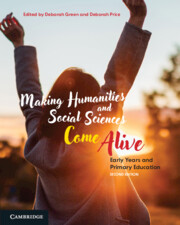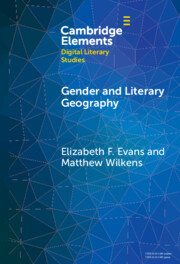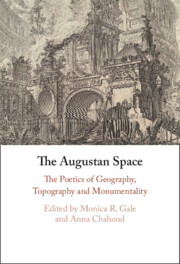Refine search
Actions for selected content:
183 results
Chapter 4 - The Geographies of British Postmodern Fiction
-
-
- Book:
- The Cambridge Companion to British Postmodern Fiction
- Published online:
- 07 August 2025
- Print publication:
- 21 August 2025, pp 66-81
-
- Chapter
- Export citation
Chapter 8 - Making Geography come alive by teaching geographical thinking
- from Part II - HASS concepts and sub-strands
-
-
- Book:
- Making Humanities and Social Sciences Come Alive
- Published online:
- 02 August 2025
- Print publication:
- 14 August 2025, pp 134-154
-
- Chapter
- Export citation

Making Humanities and Social Sciences Come Alive
- Early Years and Primary Education
-
- Published online:
- 02 August 2025
- Print publication:
- 14 August 2025
-
- Textbook
- Export citation
1 - The Balkan Peninsula and Its Languages
-
- Book:
- The Balkan Languages
- Published online:
- 31 May 2025
- Print publication:
- 26 June 2025, pp 11-64
-
- Chapter
-
- You have access
- Open access
- HTML
- Export citation
8 - Mapping the Holocaust
-
-
- Book:
- The Cambridge History of the Holocaust
- Published online:
- 16 May 2025
- Print publication:
- 12 June 2025, pp 152-173
-
- Chapter
- Export citation

Gender and Literary Geography
-
- Published online:
- 21 April 2025
- Print publication:
- 22 May 2025
-
- Element
- Export citation
23 - Papal Warfare in the Fourteenth Century
- from Part V - Papal States
-
-
- Book:
- The Cambridge History of the Papacy
- Published online:
- 28 February 2025
- Print publication:
- 20 March 2025, pp 612-631
-
- Chapter
- Export citation
“The Backside of Japan,” Development, and Imperialism in Northeast Asia
-
- Journal:
- Asia-Pacific Journal / Volume 19 / Issue 6 / March 2021
- Published online by Cambridge University Press:
- 14 March 2025, e2
-
- Article
-
- You have access
- Open access
- Export citation
1 - Global Europe
-
-
- Book:
- Globalizing Europe
- Published online:
- 06 March 2025
- Print publication:
- 13 March 2025, pp 1-26
-
- Chapter
-
- You have access
- HTML
- Export citation
6 - Tourists as Shamanic Spirits
-
- Book:
- The Shamanism of Eco-Tourism
- Published online:
- 30 January 2025
- Print publication:
- 06 February 2025, pp 125-145
-
- Chapter
- Export citation
Chapter One - Prolegomenon
-
- Book:
- The Peopling of the Caucasus
- Published online:
- 21 January 2025
- Print publication:
- 23 January 2025, pp 1-8
-
- Chapter
-
- You have access
- HTML
- Export citation
1 - Kurdistan
-
- Book:
- The Political Ecology of Violence
- Published online:
- 22 November 2024
- Print publication:
- 05 December 2024, pp 36-90
-
- Chapter
- Export citation
The geographical distribution of the family-genetic risk score for drug use disorder in Sweden and its co-localization with areas of social deprivation
-
- Journal:
- Psychological Medicine / Volume 54 / Issue 15 / November 2024
- Published online by Cambridge University Press:
- 02 December 2024, pp. 4419-4428
-
- Article
-
- You have access
- Open access
- HTML
- Export citation
6 - All Aboard? Inclusiveness in Collaborative Governance among Swedish Municipalities
-
-
- Book:
- The Politics and Governance of Decarbonization
- Published online:
- 05 December 2024
- Print publication:
- 28 November 2024, pp 119-138
-
- Chapter
-
- You have access
- Open access
- HTML
- Export citation
11 - Geographical Authority and Bodily Entanglement in Lucian’s True Histories
- from Part II
-
-
- Book:
- The Cambridge Companion to Lucian
- Published online:
- 07 November 2024
- Print publication:
- 21 November 2024, pp 224-246
-
- Chapter
- Export citation
9 - Unequal Encounters
- from Part III - Governance, Politics, and Self-Determination
-
-
- Book:
- Empire, Colonialism, and the Human Sciences
- Published online:
- 24 October 2024
- Print publication:
- 07 November 2024, pp 237-260
-
- Chapter
-
- You have access
- Open access
- HTML
- Export citation
Callimachus, Conon and Ptolemy: an Alexandrian epigram between geography and astronomy
-
- Journal:
- The Journal of Hellenic Studies / Volume 144 / November 2024
- Published online by Cambridge University Press:
- 04 October 2024, pp. 198-208
- Print publication:
- November 2024
-
- Article
-
- You have access
- Open access
- HTML
- Export citation
Groups, Identity, and Redistributive Preferences in Canada
-
- Journal:
- Canadian Journal of Political Science/Revue canadienne de science politique / Volume 57 / Issue 2 / June 2024
- Published online by Cambridge University Press:
- 22 September 2024, pp. 402-426
-
- Article
-
- You have access
- Open access
- HTML
- Export citation
Socio-legal instabilities in Ukraine’s wartime Compensation Law for damaged and destroyed residential property
-
- Journal:
- International Journal of Law in Context / Volume 20 / Issue 4 / December 2024
- Published online by Cambridge University Press:
- 19 September 2024, pp. 581-597
-
- Article
- Export citation

The Augustan Space
- The Poetics of Geography, Topography and Monumentality
-
- Published online:
- 14 June 2024
- Print publication:
- 27 June 2024
